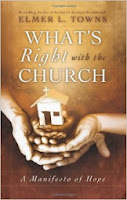
Dr. Gary Gilley
Southern View Chapel
The church is constantly being criticized by friend and foe. This is not hard to fathom as the church is a big, slow moving, easy target that is flawed because it is made up of flawed people. Much recent criticism is deserved, some is not. Towns has grown weary of those who make it their mission to point out what is wrong with the church, usually to promote their own agendas. George Barna is referenced as one such person (p. 219). As a result Towns wants to pin-point some of the things that are right about the church.
'What's Right with the Church' by Elmer Towns
Towns focuses on twelve items, devoting a chapter to each. They include being right about Jesus, the Bible, conversion, sin, family and the Great Commission. Several of these chapters are very encouraging. I also found helpful Towns' overview of six different worship styles prevalent in America today, complete with their strengths and weaknesses (pp. 103-109). The short section on Charles Finney and the invitation system was interesting as well (pp. 57-58).
Yet, What's Right with the Church disturbed me in in a number of areas:
Unverifiable statistics. For example, more than once Towns claimed that there were at least 250,000 martyrs between AD 100 and 300 (p. 15). This is unprovable.
Unverifiable generalizations and statements abound: Chinese Christianity is more vital than that which is found in the West—how does Towns know this (p. 17)? Virtually all successful church plants use contemporary praise—worship (p. 103). Is this really true? When Joseph died Jesus became the family bread winner, but we don't know when Joseph died. And what about Jesus' brothers (p. 17)?
Biblically unfounded statements: "When you read the words of the Bible the actual Spirit of God is entering your life" (p. 29); "God has a wonderful plan for your life" (p. 39); "God is looking for worship because it is the one thing He cannot do for Himself" (p. 83); "the church is Jesus Christ" (p. 133). None of these statements are scripturally sound.
Doctrinal issues: While Towns believes in salvation by grace, through faith in Christ, his synergistic comments are at best unclear.
When you think of conversion, it is one door with two sides. One side of the door is human activity, what man does, which involves the intellect, emotions and will. The other side of the door is God's activity, which is regeneration whereby God transforms people, gives them new desires, new life and makes them a part of His family. Regeneration is what God does in contrast to conversion, which is what man does (p. 50).
In this vein are a number of scriptural texts used out of context (pp. 83, 89, 117, 195, 215).
Sin. The chapter on sin is the worst in the book. Towns takes sinful behavior of various kinds and shows how such behavior is a "waste of money" (pp. 62-75). To my knowledge this is never the emphasis in Scripture. Rather, sin is first and foremost an offense against a Holy God; secondly it is deception and destructive of people, and it is damning.
Revival. The chapter on revival is almost as bad as the one on sin. For example Towns lists the ten greatest revivals in history and number one, incredibly, is the Welsh and Pentecostal Revival of the early 1900s (pp. 84-88). At least four of these "revivals" did more harm than good and some were not revivals (by any definition) at all (example: Pentecost). It was most revealing that in a footnote Towns developed this list by polling a number of Christian leaders including Pentecostals and at least two heretics (David Yonggi Cho and C. Peter Wagner) (p. 221).
Ecumenical associations. To Towns numerical success seems to trump all else (p. 95). Thus, he praises those who have distorted the gospel, taught heresy and crippled the church primarily because they are successful. This includes Bill Hybels and Willow Creek (p. 56); Jack Hayford (pp. 92-94), the Vineyard Church (p. 141), John Maxwell (p. 174), the Brooklyn Tabernacle (p. 166), John Hagee (p. 204), and the Full Gospel Church of Seoul, Korea (pp. 119-127), even calling Yonggi Cho (who has combined Buddhism with the prosperity gospel and Pentecostalism) his friend (p. 126).
Social action. Towns misunderstands the mission of the church and leans towards a social gospel (pp. 136-147). This is perhaps best illustrated when Jerry Falwell and Jesse Jackson became lifelong friends (p. 177).
Towns, co-founder of Liberty University and graduate of Dallas Theological Seminary properly recognizes there is much right about the church and he correctly identifies some of these. However, because of the concerns above I would not recommend this book.
- The Future Destiny of the Universal Church • BPB (Arnold Fruchtenbaum)
- Book Reviews: Spiritual Discipline for the Christian Life (Revised and Updated) by Donald S. Whitney (Colorado Springs: NavPress, 2014) • Southern View Chapel (Gary Gilley)
- Book Review: 'Dreams and Visions, Is Jesus awakening the Muslim World?' by Tom Doyle • BPB (Gary Gilley)
- The Nature of the Church • BPB (Thomas Ice)
- Israel-Church Differences • BPB (Andy Woods)









